- ● homepage
- ● archives
- ● restoration
- ● books
- ● big banners
- ● post board
- ■ neo's search
- ■ about us
- ■ 게재방법 안내
- 개인정보처리방침

- [email protected]
- Tel. 02_335_7922
- Fax. 02_335_7929
- 10:00am~04:30pm
- 월요일~금요일
- 3/3(월) 대체공휴일

도시-사라지는 풍경 City-disappearing landscape
정영주展 / JOUNGYOUNGJU / 鄭英胄 / painting 2013_0130 ▶ 2013_0205
● 위 이미지를 클릭하면 네오룩 아카이브 vol.20101009i | 정영주展으로 갑니다.
별도의 초대일시가 없습니다.
관람시간 / 10:00am~06:30pm
갤러리 고도 GALLERY GODO 서울 종로구 수송동 12번지 Tel. +82.2.720.2223 www.gallerygodo.com
도시- 사라지는 풍경 ● 정영주의 작업은 내가 발 딛고 있는 이곳이 무엇인가 하는 질문을 느닷없이 던져준다. ● 거대한 빌딩 앞에 오래된 주택들이 맞서듯 들어서 있다. 아득한 높이와 반듯한 창과 꾸김없는 몸체를 보이는 빌딩 아래로 낡은 지붕과 블록 담장, 오래된 대문과 굴뚝으로 이어진 주택가가 그것이다. 수직의 반듯한 선과 옆으로 끊어졌다 이어지는 좌충우돌 하는 선들로 얽힌, 서로 어울리지 않는 시간과 공간이 동시적으로 공존하고 있는 셈이다. 현실에 견고하게 뿌리박은 「도시풍경」은 그렇게 시작된다. ● 그러나 풍경 같았든 이 장면은 곧 아무런 배경 없이 빌딩 아래 낡고 작은 주택 몇 채와 병치되면서 하나의 도상으로 화면 속에 덩그러니 놓인다. 화면의 배경으로 처리되는 단색의 색상과 반복되는 도식적 형상은 현실의 구체성을 재현하거나 묘사하기보다 이 상황 자체를 지칭하는 기호로 작동한다. ● 새로 지은 빌딩의 그늘 아래 놓인 오래된 집이거나, 거대한 아파트 단지 아래 늘어선 주택가이거나, 몇 채의 빌딩 아래 덜렁 배치된 단독주택은 작품 간의 차이에도 불구하고 하나의 기호로 우리에게 주어질 뿐 현실 재현의 심급은 보이지 않는다. 도리어 같은 소재와 내용이 반복되면서 풍경은 현실에서 철저하게 분절된다. 그것은 어떤 것의 묘사가 아니라 어떤 의미의 반복된 노출과 강조에 가깝다. 구성과 색채로 해체되고 재배치되는 것이다. 느닷없는 질문이란 이런 순간을 말한다. 이번 정영주 작업에서 일견되는 태도이다.
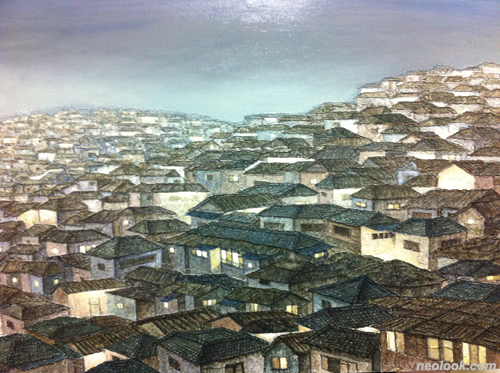
- 정영주_도시-사라지는 풍경_캔버스에 한지 꼴라쥬, 아크릴채색_70×110cm_2012
도시는 우리에게 무엇일까. 그것은 낡고 오래된 집과 골목으로 이어진 시간과 공간의 더께를 간직한 기억이다. 그 기억에 현재의 갈등과 미래의 갈망이 얽히는 곳이다. 도시는 그것 자체로 있는 것이 아니라 욕망들이 들끓고 증식하는 곳이다. 그 욕망은 기호들로 드러난다. 그 기호는 도시라는 기표로서 건물과 길과 잡다한 표지들로 이루어진다. 그 건물과 길과 표지들은 그들 스스로 증식하고 의미화 된다. 이들 사이에서 형성되는 욕망들은 서로 기대면서 두께를 만든다. 그것은 우리를 되돌아볼 이상이 어디 있는지를, 인간이 지향하는 삶의 과거와 현재를 묻고 아우르는 현장이기도 하다. ● 그러나 그가 보여주는 이 둘의 공존 관계는 도시형성의 필연적 상황임에도 불구하고 불협화로 드러난다. 선명한 대비는 통약불가능한 사태들의 표지에 다르지 않다. 그럼에도 불구하고 이런 이해에는 어딘가 모자라는 듯한 묘사와 현실의 비구체성을 들어 의미를 단순하게 말할 수 있는 위험이 있다. 그래서일까 도리어 이런 모자람에서 그 의미가 무엇인지를 묻기보다 그 기호들이 만드는 기표들의 움직임에 주목하게 한다. 일견 단순하고 선명하게 드러나는 도시의 신구, 빈부, 선택과 방기의 차이가 아니라 도시를 분절시키는 태도가 그것이다. ● 그의 「도시풍경」은 우리에게 삶을 부여하는 것이 아니라 기표들에 미끄러지는 부정된 삶에 개입하는 것이다. 어디에도 삶의 흔적이 자리 잡지 못하는 사태로서 부유하는 기호일 뿐인 도시를. 기의 없는 기표로서 끝없이 미끄러져 다닐 뿐인 황망함을 만나는 것이다. ● 어떤 정체성도 갖지 못하는, 발 디딜 곳 없이 미끄러운 기표로서 도시, 그래서 다시 묻는다. 의미가 아니라 이게 어디쯤인지를. ■ 강선학
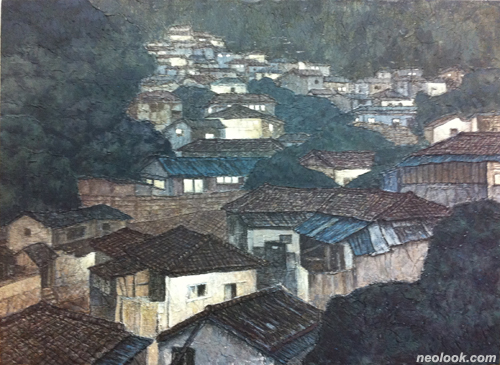
- 정영주_도시-사라지는 풍경_캔버스에 한지 꼴라쥬, 아크릴채색_53×73cm_2012

- 정영주_도시-사라지는 풍경_캔버스에 한지 꼴라쥬, 아크릴채색_43×53cm_2012
City- disappearing Landscapes ● Joong Young-Ju's works unexpectedly ask a question on the place where I am stepping on. ● Old houses are like sitting face to face before gigantic buildings. They are lined with worn-out roofs, block walls, and old gates, and are under faintly high buildings with straight windows and uncrumpled bodies. There unfittingly exist both straight vertical lines and haphazardly broken lines at the same time in the same place. That is where 「City Landscape」 starts its conversation by rooting its firm reality. ● Yet this scenery soon gets placed into a canvas as one iconographic figure juxtaposed with shabby small houses under buildings and without any background. The singular background color and repetitive iconographic conformations are working as symbols of the current condition rather than representing or describing concreteness of reality. ● For old houses under the shade of newly built buildings, residential areas under tall apartment complexes, or detached houses scattered under couples of buildings, there is no representative hierarchy but only symbolic messages that ignore certain degree of differences. Instead, this repetitiveness of the same subject matter and contents cuts away the scenery on canvas from reality. It is more like a recurrent exposure and emphasis of certain meaning rather than its portrayal. It is disassembled and rearranged by its composition and colors. The unexpected question is being asked in this very moment. And this attitude of the artist sustains though out the series. ● What is "a city" to us. It is the memory with plies of time and space through shabby old houses and streets. With that memory, conflicts of present and longings of future twurgle together. City is not just as it is, it is the place where these longings and desires boil up and luxuriate themselves. And they appear as symbols. The symbols are signifiers called as cities and are composed of buildings, streets, and sundry signs. These elements increase and symbolize by themselves. And the plies are thickened as driven desires from them lean on one another. This is the place where we ask and look back to ourselves in order to understand where our reflective ideal is and what our past and present are like. ● Although the coexisting relationship between two contrasting segments of city is an inevitable condition of city-formation, its appearance is in great dissonant. This vivid contrast is nothing different from a sign of unreducible states. Nevertheless, there could be some danger of overgeneralizing its meaning in this way of understand as it is less specific and less descriptive. Yet this cautiousness makes the viewers concentrate on the movements made by signifiers rather than studying the exact meanings of each paintings. It is the very attitude which dissects the city than its simple and plain differences in between new/old, rich/poor, and selected/neglected. ● Young-Ju's 「City Landscape」 is not presenting the life to us but participating in an indecisive life floating upon signifiers. Her works are placing audiences in the precipitous spot where they face the city that is just one flying sign for no traces of life and a signifier without a signified. ● It is about a city as one slippery signifier with no identity. Thus, here I am questioning again. And it concerns whereabout, not its meaning. ■ Kang Sun-Hak
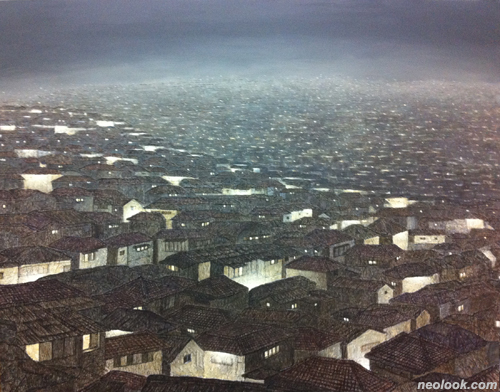
- 정영주_도시-사라지는 풍경_캔버스에 한지 꼴라쥬, 아크릴채색_92×116cm_2013
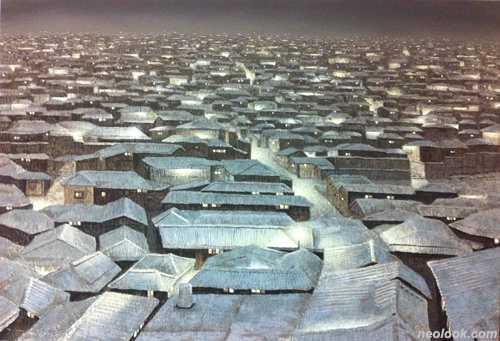
- 정영주_도시-사라지는 풍경_캔버스에 한지 꼴라쥬, 아크릴채색_86×116cm_2013
도시- 사라지는 풍경 ● 나는 도시 빌딩 숲 사이에 숨겨져 있는 판자촌을 발췌하여 풍경으로 표현하는 작업을 하고 있다. 한지를 캔버스에 붙여 형태를 만들고 그 위에 채색하는 파피에 콜레 기법을 응용한 기법인데 재료가 갖는 독특한 물성 - 빛을 흡수하여 따뜻하게 발색하는 - 때문에 나에겐 대단히 매력적인 재료이며 프랑스 유학시절부터 유럽인들에게도 반응이 좋아 지금까지 작업의 재료로 쓰고 있다. ● 종이 조각 하나하나가 모여서 집이 되고 하나의 마을을 이루며 세계를 만들듯이 과거의 추억을 머금고 있는 기억의 조각조각들이 한 데에 모여 현재의 나라는 세계를 만든다. 집이라는 것은 단순히 물리적 공간을 넘어 나의 정신과 문화의 터전이며 또한 나의 역사이기도하다. 그러나 사람들은 너무도 쉽게 부수고 잊어버리고 새로운 것을 탐닉하고 있다. 자고 일어나면 없어지고 새로 생기곤 하는 빌딩들이 과연 나에게 어떤 기억을 만들어줄 수 있을지... 그곳엔 사람은 없다, 아니 나는 없다.. 거대한 빌딩 속에서 소외된 채 숨어 살고 있는 판잣집과 숨겨진 추억들을 과감하게 등장시켜 그들에게 주인공의 역할을 부여해주고 싶다. 동시대에 존재하면서도 거대한 자본주의의 논리에 가려져 보이지 않는 그들과 그것들.(그것이 무엇이든지 간에) 도저히 주인공이 될 수 없는 현실... ● 나는 나의 작업을 통해 소외된 것들과 잊혀진 것들을 그 속에서 끄집어내어 그들의 파라다이스로 바꿔보고 싶었다. 현재의 모습이면서 과거의 그 것처럼 보이기도 하는, 중의적 시간성이 또 다른 초현실적 분위기를 만들어내고 시간을 초월한 그 무엇은, 나로 하여금 내가 서있는 곳이 어디 인지,를 다시금 되돌아보게 한다. 한지가 빛을 흡수하듯이 나를 흡수하듯 받아들이는 따뜻한 마을의 모습을 통하여 내 작품을 보는 이들에게 언제든 지치거나 힘들 때 돌아가면 받아주는 마음속 고향 같은 따뜻함과 고요한 안정감을 느끼게 하고 ,인간에게 진정으로 소중한 것은 무엇인가를 한번쯤 생각하게 하고자 한다. ■ 정영주
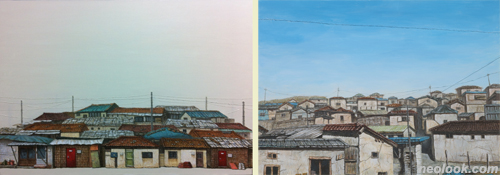
- 정영주_도시-사라지는 풍경_캔버스에 한지 꼴라쥬, 아크릴채색_53×73cm_2013 정영주_도시-사라지는 풍경_캔버스에 한지 꼴라쥬, 아크릴채색_53×73cm_2012
City- disappearing landscape ● My working is about portraying shanty town hided by packed buildings in the city. I usually paste korean handmade paper on the canvas and then color, which is similar to 'papier colle' technique. I really like that technique because of the korean hand made paper's unique characteristics which absorb sunlight and reveal it warmly, so I am using this materials in my works from when I had studied in Paris. ● For me, what I am is the assemble of all fragments of my memories in the past. I want to do the same thing in my works with papers on the canvas like making a house, town and world with hundreds of pieces of papers in my works. House is not only a physical space but also the base of my spirit and culture as well as my private history. But many people always pursue something new while they easily forget and destroy the old ones like old houses in the shanty town. Can new buildings around us which suddenly appear overnight make good memories to me and other people? No, there is no human nature, there is no me. So I want to give disappearing shanty town and old memories a important role as a main actors in our life in my works. In this respect, my works are really paradoxical cause it is impossible shanty town and old memories would be a mainstream in this generation covered with massive buildings and capitalism. ● My works are some kind of attempt to express paradise with somethings alienated or forgotten. I also want to take some time for self-examination with my works because I usually express city landscape which looks like the present as well as looks like the past, which is something surpassing the time. I wish my works give some silent stability and warmth to the audiences who have some difficulties or got tired with warm shanty town on my canvas. Moreover, I wish my works want to be a good guidance to the audiences which make them think what are the most valuable things to the human natures. ■ Joung young-ju
Vol.20130130d | 정영주展 / JOUNGYOUNGJU / 鄭英胄 / painting

